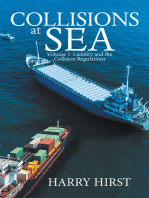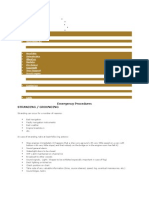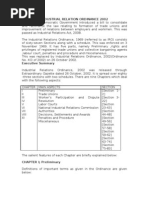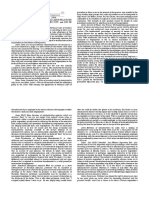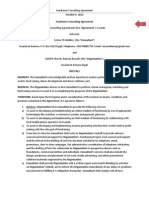T/C - Speed and Consumption Claim
T/C - Speed and Consumption Claim
Uploaded by
AdemEskiciCopyright:
Available Formats
T/C - Speed and Consumption Claim
T/C - Speed and Consumption Claim
Uploaded by
AdemEskiciOriginal Description:
Original Title
Copyright
Available Formats
Share this document
Did you find this document useful?
Is this content inappropriate?
Copyright:
Available Formats
T/C - Speed and Consumption Claim
T/C - Speed and Consumption Claim
Uploaded by
AdemEskiciCopyright:
Available Formats
T/C Speed and
consumption claim
Charter party Speed and consumption Whether vessel
underperformed on certain voyages Whether owners entitled to set
off under-consumption of MDO across entire period of charter.
he vessel was chartered on the
NYPE form (1946) for minimum
30 months up to maximum 36
months, exact duration in charterers
option. At the conclusion of the charter the charterers withheld hire to reflect
their claims for underperformance on
voyages Nos. 13 and 14. The charter
party provided:
29: Detailed Description of Vessel
(a) Speed/Consumption up to/including
Beaufort Force 4 and Douglas Sea State 3:
Speed/Consumption: about 15 knots
(Ballast)
About 14 knots
(Laden)
On about 55 MT
380 CST + about
0.5 MT MDO
(b) Speed Clause
Throughout the currency of this Charter,
Owners warrant that the vessel shall be capable
of maintaining and shall maintain on all sea
passages from seabuoy to seabuoy speed and
consumption as per vessels description. Speed
and consumption figures are always about and
provided and always in good weather conditions and no adverse currents. Good weather
condition means winds and conditions of up to
maximum Force 4 Beaufort and Douglas Seastate of up to maximum 3.
a consistent discrepancy between the deck
logs and independent bureau reports, then
the matter to be referred to arbitration, if
not settled amicably.
The charterers said that during voyages
13 and 14 the vessel had under-performed
during periods of good weather, and that
accordingly the charterers were entitled to
extrapolate the vessels under-performance
during periods of good weather to the entire
voyage including periods of bad weather,
in accordance with The Didymi [1988] 2
Lloyds Rep. 108 and The Gas Enterprise
[1993] 2 Lloyds Rep. 352.
The owners said that in any under-performance claim it was first necessary to assess
average performance. For that purpose performance only during good weather days as
defined, excluding adverse currents, should
be looked at. In order to allow average performance to be assessed it was necessary
to consider a reasonably sufficient number and spread of such good weather periods. The average performance thus arrived
at was then to be applied appropriately over
the total time spent on all sea passages over
the life of the charter, not only to periods of
good weather, to assess whether over the life
of the charter there had been an under or
over-performance.
(c) Weather Routing and Speed/Consumption Deficiencies
Charterers may supply ocean routes advice
or similar service to the Master during voyages specified by the Charterers. The Master
to comply with the reporting procedure of
the routing service selected by Charterers.
Evidence of weather conditions to be taken
from the vessels deck logs and independent weather bureau reports. In the event of
The owners said that to do what charterers
had done and select only two voyages out of
17 during the charter period and then seek
to calculate a figure for the vessels average
good weather performance solely by reference to performance on those two voyages
was not a reasonable reflection of the vessels average performance over the course of
the charter. Instead, what was required was
an assessment based upon a much wider
spread of performance across the 17 voyages actually performed.
122
LONDON ARBITRATION
BULLETIN 2013
VOLUME 108
#3
The owners submitted their own calculations of the vessels average performance
by reference to laden voyages during the
whole period of the charter, based on good
weather days as reported by the Master in
his voyage reports. The owners asserted that
those calculations demonstrated an average
performance on good weather days of 13.79
knots over the entire charter period. Thus,
the vessel did not underperform as alleged
or at all since, applying The Didymi principle, there was on average no under-performance in good weather.
The charterers responded that the wording
of clause 29(b) in the present charter was
distinguishable from the wording of the
charter in The Didymi. In particular, references to the vessels performance on an
average basis throughout the duration of
the charter party were missing in the present clause. Instead it contained a warranty
that the vessel shall be capable of maintaining and it shall maintain all sea passages from sea buoy to sea buoy, sea speed
and consumption as per vessel description.
That, the charterers argued, entitled them
to consider each sea passage separately and
claim in respect of any of them where they
considered there had been a breach of the
warranty.
Held, that the charterers interpretation
of clause 29(b) was correct. The wording
of that clause, particularly the reference to
all sea passages, entitled the charterers
to select any of the sea passages whether
in ballast or laden and subject those to the
charter party warranty of speed and consumption. The charterers were entitled to
apply The Didymi principle to the two voyages in question to seek to establish that the
vessel under-performed on average during
good weather periods, albeit that on some
good weather days she did achieve the war-
ranted speed. The tribunal would reject the
owners argument that The Didymi principle entitled them to consider all the voyages
under the charter to show that the vessel
was capable of performing her warranted
speed in good weather.
As to the application of the The Didymi
principle, in respect of voyage 13 the charterers had sought to justify a deduction
of USD 34,017.95 in respect of the vessels under-performance. That figure was
arrived at by claiming 40.89 hours lost plus
54.75 mt IFO over-consumed less 3.73 mt
MDO under-consumed during the voyage.
The 40.89 hours was supported by a Danish Meteorological Institute (DMI) report.
That report measured the figure of 40.89
hours by taking the warranted speed of 14
knots laden and then deducting 0.5 knots
for about; 0.52 knots for average weather
factor; and 0.02 knots for average current
factor, thereby producing an adjusted warranted speed of 12.96 knots. That resulted
in the time the voyage should have taken of
899.02 hours (11,651.26nm 12.96). As the
actual time taken was 939.91 hours, deducting 899.02 hours gave the figure of 40.89
hours for the under-performance.
las Scale) conditions were above sea state 3
(1.25 m), varying between 3 m (on 14 July)
and 6 m (on 21 July).
The assessment of sea conditions was not
an accurate science and log entries were at
times made with half an eye on the charter
warranties. It was also noteworthy that the
log entries for 14 July showed that for three
of the six, 4-hourly, entries, the sea state was
recorded as slight (i.e. force 3) and for only
three that it was moderate.
Another very curious day was 21 July, on
which both the DMI Report and the Passage Report calculated an average speed of
8.58 knots. The DMI Report assessed the
wind as force 3 and the sea state as 1. The
Passage Report showed the wind as force
4, but the sea swell as 6 m Heavy Sea.
The actual log entries, however, recorded
the wind force decreasing after 08:00 hrs.
to force 4 and the sea from rough to moderate after 16:00 hrs. Only 206 miles were
sailed on that day according to the Passage
Report, considerably less than on days when
the weather was worse, such as 4 July (wind
force 9, swell 8 m almost dead ahead)
when 280 miles were covered.
The owners had argued that adverse currents were recorded during 30% of the voyage; that the wind conditions exceeded
force 4 during two-thirds of the voyage; and
that apart from one day the sea was well
above sea state 3 (which was represented by
between 0.5 m to 1.25 m for wind sea, and
by light short and moderate waves for
swell conditions, per the Euro Weather
website description of the Douglas Scale).
The charterers had contended that the DMI
report showed that the vessel under-performed even on days of good weather and
without the existence of adverse currents.
In the tribunals opinion the evidence established that during voyage 13 the vessel did
underperform on days of good weather as
defined in the charter.
The facts of the voyage varied somewhat
depending on which source was taken for
them. According to the DMI report, on
days when good conditions were encountered, (both wind and sea), which were 1-3;
14; 17; 21; 23-31 July; 1-4; 8-9 August, the
vessel did not always reach her (adjusted)
warranted performance speed. The charterers had particularly drawn attention to
certain days, e.g. 14; 17; 27 July and 4 and
8 August when she fell below that speed.
The Passage Report (an abstract of the log
entries) with one exception confirmed that
the wind on those days was at or below force
4. It showed, however, that the sea (Doug-
The owners had again argued that, save
for three days out of the 45 day voyage, the
weather conditions were such that the charter party warranty was not applicable, there
being either adverse currents, or wind or
sea conditions in excess of those in the warranty. The charterers had pointed to the
vessel underperforming on 9 and 10 September, on 24 and 25 September, on 28 and
29 September, and between 2 and 5 October 2003.
Voyage 14 consisted of a ballast leg and then
a laden voyage. The charterers had claimed
under-performance of 27.80 hours and IFO
over-consumed of 39 mt, totalling USD
24,217.38. That claim comprised 2.7 hours
lost and 0.4 mt over-consumed on the ballast leg, and 25.1 hours lost and 38.6 mt
over-consumed on the laden leg, according
to a WNI Oceanroutes report.
however, the Passage Report showed swell
of only 1 m (or sea state 3 on the Douglas Scale). Adverse currents were recorded
on the Passage Report for those days but
the WNI Report disagreed as regards 1-4
October and only considered there was 0.12
knots adverse current on 29 September.
Again, it was the tribunals opinion that
the evidence did establish that the vessel was under-performing on some good
weather days so as to entitle the charterers
to assess the vessels under-performance on
the entire voyage 14 pursuant to The Didymi approach.
The owners had contended that they were
entitled to set off any overall saving in fuel
consumption against the charterers underperformance claims. They had argued
that warranted consumption, taking into
account the margin implied by the qualification about, which should be 5%, was
57.75 mt 380 CST and 0.525 mt of MDO;
and that the total saving made by charterers
by reason of under-consumption across the
charter was more than sufficient to extinguish their underperformance claims by
reason of owners consequent claim/set off.
The owners set-off argument would be
rejected. They could not rely on underconsumption across the charter in the
absence of a specific clause entitling them
to such a right. The most they could do was
to seek to apply the principle in The Ioanna
[1985] 2 Lloyds Rep. 164 to the two voyages
in question. However, the charterers had
already given credit for such under-consumption of MDO as there had been, and
no further allowance was to be given to the
owners in that respect.
Accordingly the charterers were justified in
withholding from hire the sum claimed by
owners whose claim for unpaid hire failed
and was dismissed. l l
Editors Note: The above is a summary of
a London Arbitration Award (No. 3/12)
which appeared in Lloyds Maritime Law
Newsletter No. 854 of 17 August 2012
and which is reproduced by the kind per-
On 9/10 September, and again on 24/25 September the Passage Report showed Swell of
3-4 m. On 29 September and 1-4 October,
LONDON ARBITRATION
mission of the publishers, Informa Law.
BULLETIN 2013
VOLUME 108
#3
123
You might also like
- CHP 9 - Refund - Guarantees - 9 - THE - BIMCO - NEWBUILDCON - Standard - Newbuilding - Contract - Part - II, - Annex - A - (Iii)No ratings yetCHP 9 - Refund - Guarantees - 9 - THE - BIMCO - NEWBUILDCON - Standard - Newbuilding - Contract - Part - II, - Annex - A - (Iii)13 pages
- Anchorages and Marinas of the Eastern Canaries: Sailing off the Coasts of Lanzarote, Fuerteventura and Gran CanariaFrom EverandAnchorages and Marinas of the Eastern Canaries: Sailing off the Coasts of Lanzarote, Fuerteventura and Gran CanariaNo ratings yet
- Approaching Pilot Stations and Embarking and Disembarking100% (1)Approaching Pilot Stations and Embarking and Disembarking35 pages
- CHIRP Making Critical Decisions at Sea 2019 09100% (1)CHIRP Making Critical Decisions at Sea 2019 0920 pages
- CHIEF MATE PHASE 2 Anchoring 10.4 and 10.5100% (1)CHIEF MATE PHASE 2 Anchoring 10.4 and 10.548 pages
- 2014 04 Guidance For Accurate Draft Reading100% (1)2014 04 Guidance For Accurate Draft Reading2 pages
- Hypothermia: Photo by Belchonoc/depositphotosNo ratings yetHypothermia: Photo by Belchonoc/depositphotos3 pages
- Effect of Free Surface & Six Degree FreedomNo ratings yetEffect of Free Surface & Six Degree Freedom4 pages
- What Is E-Navigation?: Share Tweet Share Whatsapp +1No ratings yetWhat Is E-Navigation?: Share Tweet Share Whatsapp +13 pages
- Focus: Is Your ECDIS Contributing To Safe Navigation or Introducing Risk?100% (3)Focus: Is Your ECDIS Contributing To Safe Navigation or Introducing Risk?5 pages
- General Stores Declaration - Bonded Store Declaration100% (1)General Stores Declaration - Bonded Store Declaration11 pages
- 31A INTERTANKO - Guide For Correct Entries in ORB Part INo ratings yet31A INTERTANKO - Guide For Correct Entries in ORB Part I23 pages
- Rule of The Road: A Quiz For Navigating Officers100% (1)Rule of The Road: A Quiz For Navigating Officers11 pages
- Mooring Operations Manual: Marine Department Port of Tilbury London LimitedNo ratings yetMooring Operations Manual: Marine Department Port of Tilbury London Limited48 pages
- Unit Fifteen Sea Protest: Wind and Sea Ship Is DamagedNo ratings yetUnit Fifteen Sea Protest: Wind and Sea Ship Is Damaged16 pages
- MSC.1-Circ.707 - Guidance To The Master For Avoiding DangerousSituations in Following and Quartering Seas (Secretariat) PDF100% (1)MSC.1-Circ.707 - Guidance To The Master For Avoiding DangerousSituations in Following and Quartering Seas (Secretariat) PDF14 pages
- ABS - Ballast Water Exchange ProceduresNo ratings yetABS - Ballast Water Exchange Procedures26 pages
- AMSA - BULLETIN Thinking - Mooring SafetyNo ratings yetAMSA - BULLETIN Thinking - Mooring Safety4 pages
- Isps Station Drill: Passenger & Follow Master Instruction, Other Officers, Engineers, CrewsNo ratings yetIsps Station Drill: Passenger & Follow Master Instruction, Other Officers, Engineers, Crews1 page
- Measurement of Bulk Cargoes - Draught SurveysNo ratings yetMeasurement of Bulk Cargoes - Draught Surveys18 pages
- Deck Department Leadership Through Bridge Team ManagementNo ratings yetDeck Department Leadership Through Bridge Team Management4 pages
- Everything We Do at Sea: We Will Keep You UpdatedNo ratings yetEverything We Do at Sea: We Will Keep You Updated13 pages
- Instruction For Trust Account: Sogotrade New Account ContactNo ratings yetInstruction For Trust Account: Sogotrade New Account Contact10 pages
- Lost Profit and Capital Investment: by Michael PrylesNo ratings yetLost Profit and Capital Investment: by Michael Pryles16 pages
- D R Mithra Dharmaraj Objection Interim Order District CourtNo ratings yetD R Mithra Dharmaraj Objection Interim Order District Court3 pages
- Tax Invoice: Being Amount Paid For Advertising Listings On Just DialNo ratings yetTax Invoice: Being Amount Paid For Advertising Listings On Just Dial2 pages
- de Ysasi III vs. National Labor Relations CommissionNo ratings yetde Ysasi III vs. National Labor Relations Commission15 pages
- New Principles of Sovereign Immunity From Enforcement in IndiaNo ratings yetNew Principles of Sovereign Immunity From Enforcement in India2 pages
- Case Concerning Kasikili/Sedudu Island (Botswana/Namibia)No ratings yetCase Concerning Kasikili/Sedudu Island (Botswana/Namibia)111 pages
- Arif Azim Co. Ltd. Vs Aptech (Arb Pet 29 of 2023)No ratings yetArif Azim Co. Ltd. Vs Aptech (Arb Pet 29 of 2023)58 pages
- Ralph Jonathan Alvarado Vera v. Cruise Ship Catering and Services International, N V., 11th Cir. (2014)No ratings yetRalph Jonathan Alvarado Vera v. Cruise Ship Catering and Services International, N V., 11th Cir. (2014)11 pages
- Passenger Services Conference Resolutions Manual: Resolution 7800% (1)Passenger Services Conference Resolutions Manual: Resolution 78034 pages
